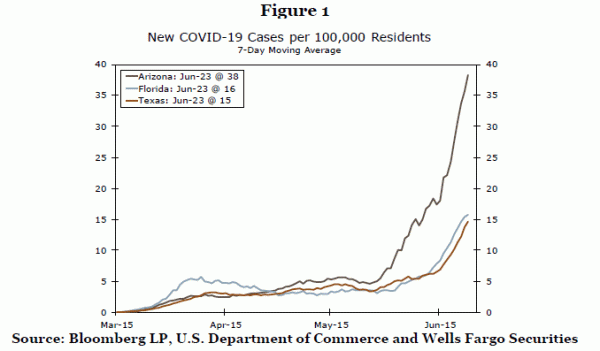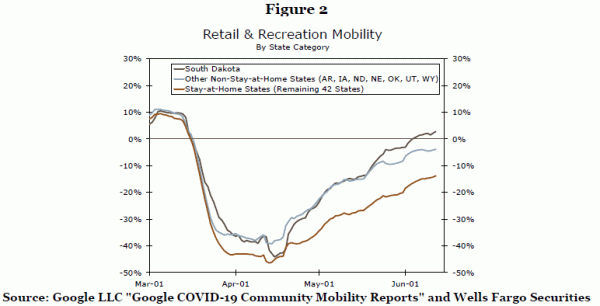COVID-19 on the Rise in Several U.S. States
Lockdowns had been at least partially lifted across most of the United States by the end of May, when new coronavirus cases were broadly trending lower. However, a wave of new COVID-19 outbreaks now appear to be spreading throughout the country. As of the third week of June, new coronavirus cases are trending higher in over 20 states, several of which are seeing record highs (Figure 1). This uptick in case growth has raised concern over the likelihood of a steady U.S. economic recovery
Renewed outbreaks of COVID-19 could cause state and local governments to slow down or even rollback re-opening plans. While limiting social interaction may be necessary from a public health perspective, it would curtail economic activity and potentially set back the recovery. Even without official government intervention, there is also the risk that a renewed outbreak could curb spending if households pull back from the economy or businesses close out of fear of the virus
To Lockdown or Not to Lockdown: That Is Not the Only Question
At this point, there seems to be little appetite for widespread stay-at-home orders or business closures such as those implemented in most states in late March and April. Still, the intensification of the virus could by itself harm economic activity, even in the absence of new lockdown orders. We see two main takeaways:
1. Even if states refrain from ordering residents to stay at home, cities and localities may choose to impose more restrictive measures, or businesses/residents might opt to self-restrict activity. The resultant decline in activity likely would not be as steep as in a full lockdown, but might nevertheless be substantial.
2. Formal, state-wide lockdowns tend to depress activity and mobility substantially more than other mitigation measures. Figure 2 shows a clear difference in mobility in states that implemented stay-at-home orders versus those that did not. Recent research from economists at UC Davis confirms this finding.1 Barring another round of widespread stay-at-home orders, we have probably seen the bottom in output.
U.S. mobility to retail and recreation sites abruptly declined starting around March 15 (Figure 2). This sharp drop predates stay-at-home orders in many states, some of which were not implemented until early April. Instead, the initial drop-off in mobility may have been caused primarily by school closures (most of which occurred right around March 15) and increasingly cautionary news coverage. Nationwide, Google searches for “coronavirus” peaked on March 15, and a state of emergency was declared on March 13.
Several states directed some ‘nonessential businesses’ to close but never issued statewide stay-at-home orders (Arkansas, Iowa, Nebraska, Utah, North Dakota and Wyoming). In these states, mobility still declined sharply, albeit not to the same extent as in those states which implemented formal stay-at-home orders (“Stay-at-Home States” in Figure 2). A similar pattern can be observed in South Dakota, which was the lone state to refrain from implementing a statewide stay-at-home order or mandated business closures throughout March and April.2 Retail and recreation activity in the state abruptly pulled back on March 15, about a week before state officials offered recommendations for businesses to safely remain open.3 Jobless claims in the state also began to spike during the week ending March 21, meaning South Dakota businesses clearly saw a down shift in demand.
However, looking only at measures taken at the state level misses important nuances. Several localities and cities in South Dakota issued states of emergency, mandated business closures, or limited capacity at restaurants and other establishments. Even in areas where closures and restrictions were not mandated, businesses in some cases decided amongst themselves that temporary closures were the right approach.4
The Road Ahead
Texas serves as an important example. Among the states that have seen the sharpest increase in cases, Texas has drawn particular attention due to the rising pressure on its hospital system. In a recent press conference, Texas Governor Abbott said that closing down the state again “will always be the last option.” However, Abbott also granted more leeway to county officials to restrict outdoor gatherings, and there have been increasing reports of bars and restaurants closing, particularly in major cities such as Dallas and Houston. Rather than reverting to a full lockdown, states such as Texas with surging case numbers may instead opt to slow or halt phased re-openings and take other marginal measures depending on the severity of new case growth. South Dakota reminds us of the importance of focusing on local mitigation measures in addition to state-wide restrictions.
Overall, the rise in new cases presents a nuanced threat to the U.S. and global economic recovery. A decline in activity on the order of what we saw in March/April seems highly unlikely given the apparent unwillingness of many states to fully lock down again. However, periodic setbacks on the road to recovery seem likely as parts of the United States continue to see spikes in cases. Thus, rather than a straight line higher, the path of output from here is likely to be more uneven until a vaccine or other treatment is made widely available.
















